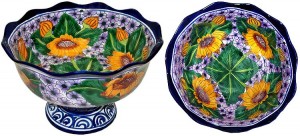During the 8th century, the Moors from Northern Africa conquered Spain. The Moors brought with them majolica pottery. Majolica is an art form that is known for its unique glazing process and exquisite design details. A major component of majolica is its glazing technique which contains tin as an ingredient. This technique for applying the glaze creates a creamy-white background that is perfect for applying colorful designs. The designs and use of mineral pigments originated from the Moors who conquered Spain and had tremendous influence on all the artistic expressions of Spain.
Egyptian Contribution
During the 8th century, the Arabs controlled Spain. The process of pottery making was first developed in ancient Egypt and was later refined by the Chinese. The production of pottery became very popular as a result of the Arab occupation of Spain. Muslim potters brought knowledge of using different materials and new techniques that radically changed pottery production in Spain. As a result, their influence was widespread. After the expulsion of the Muslims in the 16th and 17th centuries, many potters continued to use the intricate designs and vibrant colors such as copper green and manganese purple-black which were well known in Islamic pottery.
Chinese Contribution
In the late 16th century Spain opened trade with China by way of Mexico. As a result of the Chinese imports, the Mexicans began to incorporate the designs that were found on the Chinese porcelain. For example, the floral and feather motif to fill empty spaces on the blue and white Talavera exhibits Chinese influence. China contributed much of the motifs used today in Mexican talavera. The blue and white color, panel design, and even the barrel-shaped pottery were some of the Chinese influences that we still see today on modern pieces of talavera pottery.
Spanish and Mexican Contributions
The indigenous people of Mexico, long acquainted with making items from clay, had their own distinct method of producing earthenware, one which did not involve glazing or the use of the potter’s wheel. The indigenous people of Mexico had a rich and long history of producing pottery long before the arrival of the Spaniards. However, with the arrival of the Spaniards in the 1600s new techniques such as the wheel, tin based glazes, and new styles were introduced. The combination of the newly learned Spanish techniques and the techniques of the indigenous people of Mexico gave birth to a new form of pottery, talavera. The name talavera is derived from the city Talavera de La Reina, Spain. The Spaniards from this city brought their pottery craftsmanship to the new world and taught the indigenous people of Mexico the art. Mexico was very proud of their new found success in the production of high quality talavera. In order to prevent th talavera from losing its high quality craftsmanship, the Potter’s Guild was formed in 1653. The Potter’s Guild set forth ordinances regulating the production of talavera pottery. The Potter’s Guild was replaced by the Talavera Regulating Council in 1993.
The Moors, Chinese, Egyptians, Spaniards, and Mexicans should all be credited for the creation of Mexican talavera pottery. After their creation, the Potter’s Guild and the Talavera Regulating Council have worked hard to keep talavera authentic and of high quality. The lovely pieces of Mexican talavera pottery are a multicultural, regulated art form that expresses centuries of dedication and gratitude for its heritage. So next time you think, “Mexican talavera pottery,” you will actually be thinking, “Moor, Chinese, Egyptian, Spanish, and Mexican talavera pottery!”

